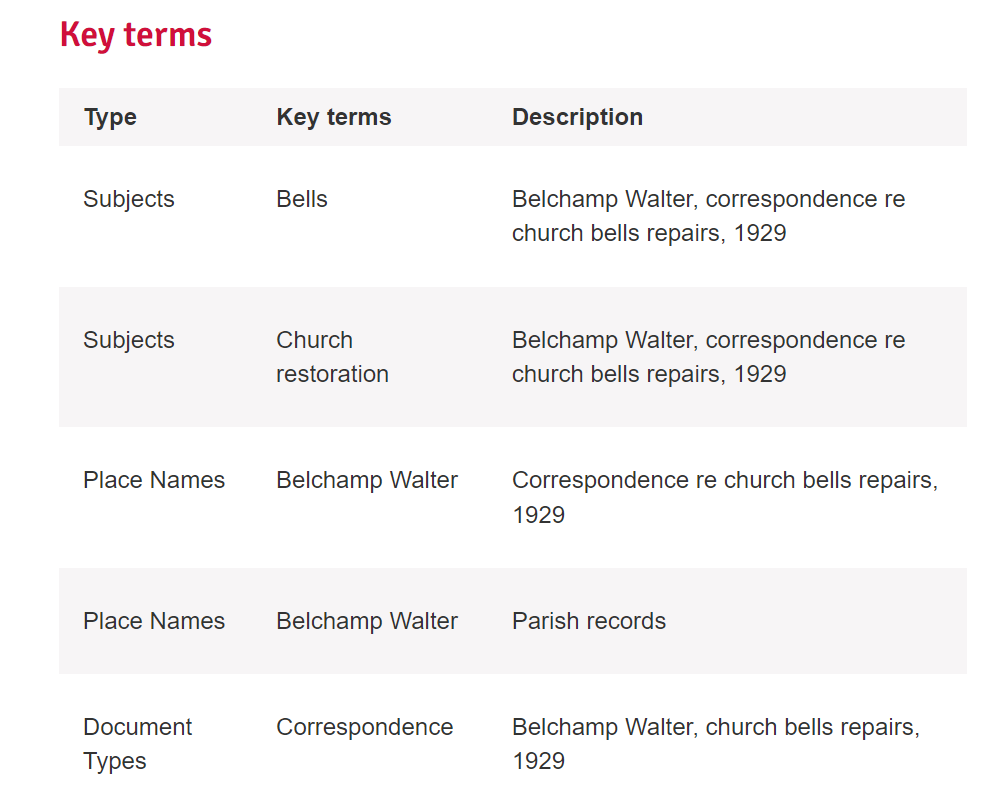Repairs on the Bells at St Mary Belchamp Walter
Having started this page as a historical account of the repair of the Bells and Belfry of the Church
of St. Mary, Belchamp Walter, it seems that this now a current issue that needs to be
addressed by the PCC/Friends.
Peter Woollam, Lichfield DAC Bell Adviser, seems like a good person to contact regarding this matter as his
report: NOTES ON BELLS, BELL HANGING, BELL RINGING AND BELL RESTORATION, as current in 2018.
If you search the Essex Archive for item Reference D/P 215/6/4 you will get the following information:
Top
The estimates that would have been determined in 1929 are not likely to reflect the cost that would be incurred
if the bells and belfry were to be renovated in 2022.
As the bells were last run in 1923 they were probably in working order at that time. It was likely that it was
determined that to prevent any damage and risk of injury that repairs needed to be made on them at the time.
Without looking at the correspondence in the Essex Archive it is not known whether the "repairs" are for just the
bells, cracks and tuning or similar. It is not easy to see if there are any such defects in the bells as they exist now.
It is pretty amazing that such a small tower houses 8 bells. Many similar size churhes in the local neighbourhood often
only have 3 or 4 bells.
Background to this page
Having seen some of my history pages being found by those making an Internet search I have decided to add
a bit more context on how the pages came about.
As the original interest in my "Bells" page was from a post made on Facebook I have
no way of determing what the "trigger" for the interest was.
The Friends of St. Mary Belchamp Walter
have plans (or asiprations) to renovate the bells and the belfry.
The Friends Group are holding a Plant and Bake sale on the 14th May 2022.
Please feel free to contact the webmaster for more details.
Peter Woollam, Lichfield DAC Bell Adviser
Having reviewed the quinquennial report relating to the condition of the bells and the ringing mechanism I came
across the following:
"
BELL FRAMES: Church bells are often not seen by their listeners, but at least they are heard. Bell frames are
very much ‘out of sight, out of mind’ and belfries are visited by very few, often not even by the incumbents
and churchwardens who have the primary responsibility for their care. Nevertheless, they often reveal the
craft, ingenuity and sheer determination of their makers and lead us to marvel at the achievements of our
forebears, given the crude tools (by today’s standards) available to them.
"
"
Old timber frames can create difficulties for change-ringers and, in severe cases, cause damage to tower
masonry. If the joints between sections have loosened, then the frame will distort during full-circle ringing.
This acts to dissipate some of the energy expended by the ringers, who must work harder as a consequence. It
is not unknown for the heavier bells in a ring to cause sudden ‘shifting’ of elements of the frame. Such
movement is, typically, measured in only small fractions of an inch but may be sufficient to disturb the
swinging of the lighter bells. Ringers strive to exert precise control in order to produce regular striking, but a
‘mobile’ frame can make this very difficult to achieve. In the most severe cases, and where the perimeter of a
frame lies close to the tower walls, movement of a frame can effectively turn it into a ‘battering ram’ with
consequent damage to masonry.
"
"
Bell installations often illustrate the ‘cutting edge’ technology of their day and very old bell frames, together
with those having interesting or unique features, are well-deserving of conservation. This is sometimes seen
as ‘inconvenient’ by enthusiastic ringers who lament their structural under-performance by comparison with
modern frames. Nevertheless, where it is judged that timber frames of historic interest are no longer ‘fit for
purpose’ and cannot be adequately strengthened by the addition of steelwork, they may have to be retained in
the tower and space found for the insertion of a new steel frame.
"
"
An Ellacombe chime system operates with bells hung stationary and with a hammer beneath each bell that
rises and strikes on tugging a rope ([originally]Fig. 6). Unlike full-circle ringing, where the diameter of the bell wheel produces a large excursion of the rope, the movement here is minimal. Ellacombe ropes can be routed to
descend to a compact rack where they are within easy reach of one individual. It is not unusual to find
Ellacombe racks in towers with bells hung for full-circle ringing, thus offering the option of either technique.
It is this author’s experience that these are very little used.
"
My recomendation (but I am not a bell expert or a qualified architect)
The size of the belfry is such that housing of 8 bells in such a small space makes the preservation of the timber
frames, as they are of historical interest, impossible as there is no space for the insertion of a new steel frame.
Even if this could be physically done the cost is well beyond the scope of fund-raising for the Church.



